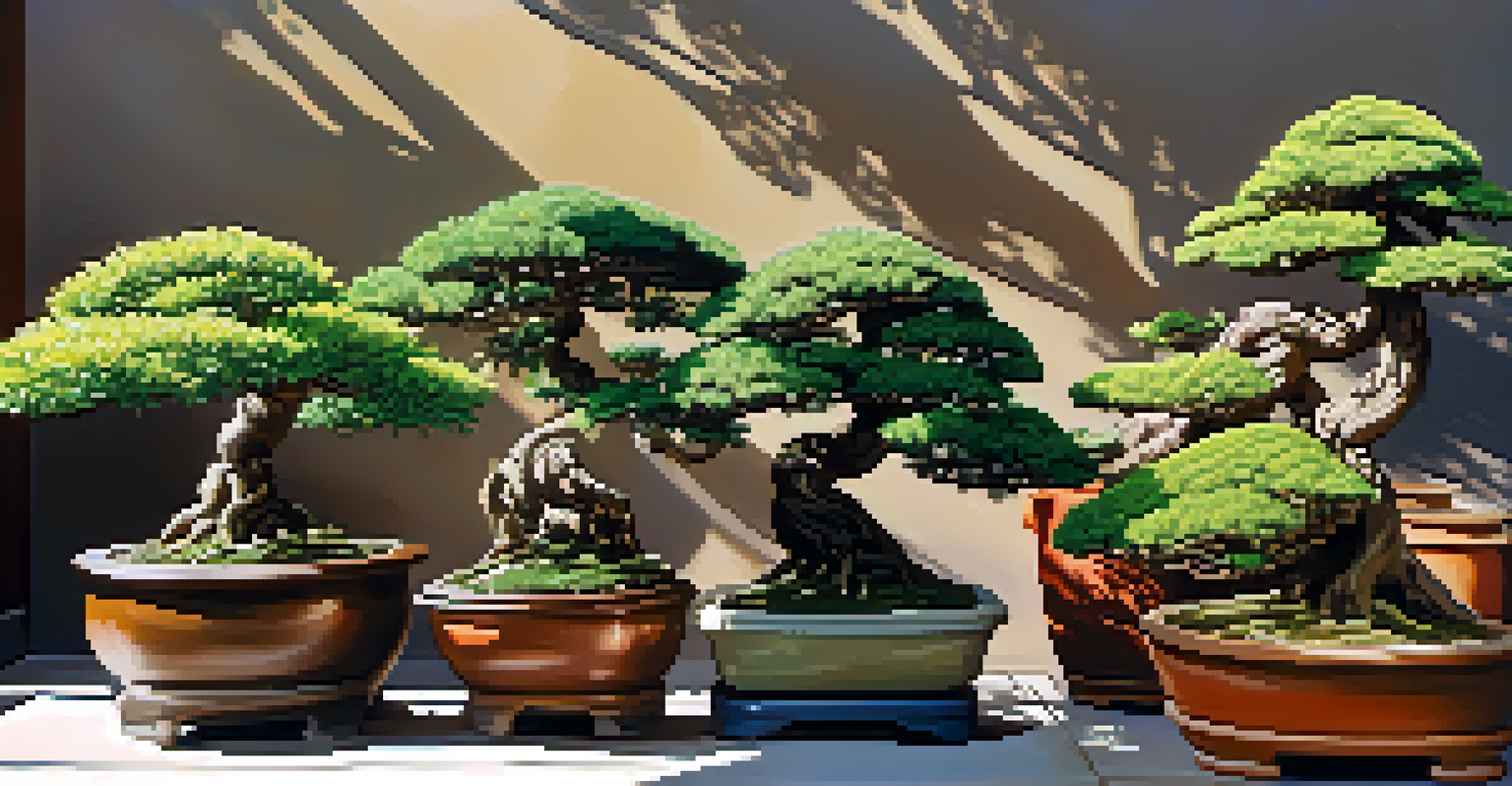Watering Your Bonsai: Tips for Optimal Growth and Health

Understanding Your Bonsai's Water Needs
Bonsai trees, like any other plant, have specific water requirements that vary based on species, size, and the environment in which they are kept. Understanding these needs is crucial for optimal growth and health. For instance, tropical bonsai may need more frequent watering compared to those adapted to drier climates.
Water is the driving force of all nature.
To determine when to water, pay attention to the soil's moisture level. A simple test is to stick your finger about an inch into the soil; if it feels dry, it’s time to water. This tactile method helps you develop a better sense of your bonsai's hydration needs over time.
Remember, different seasons can affect water needs too. During summer, when temperatures soar, your bonsai might require more water. Conversely, in winter, you may need to reduce watering as the plant's growth slows.
Choosing the Right Watering Method
There are several methods to water your bonsai, each with its advantages. The most common approach is using a watering can with a fine spout, which allows for precise watering without disturbing the soil too much. This method helps ensure even moisture distribution.

Another popular technique is the immersion method, where you submerge the pot in a basin of water until bubbles stop rising. This allows the soil to absorb water evenly from the bottom up, which can be especially beneficial for bonsai with dense root systems.
Monitor Bonsai Watering Needs
Understanding your bonsai's specific water requirements is essential for its health and growth.
Regardless of the method you choose, the key is to avoid overwatering. Too much water can lead to root rot, a common problem that can quickly endanger your bonsai's health.
Identifying Signs of Overwatering
Overwatering can be detrimental to your bonsai, and recognizing the signs early can save your plant. Common indicators include yellowing leaves and a mushy texture in the roots. If you notice these symptoms, it’s crucial to adjust your watering habits immediately.
Plants are like people; they need water to survive.
Another sign of overwatering is the presence of mold or algae on the soil surface. This not only looks unappealing but can also indicate unhealthy soil conditions. Regularly inspecting your bonsai can help catch these issues before they escalate.
If you suspect overwatering, allow the soil to dry out before watering again. This pause helps restore the balance and gives your bonsai a chance to recover.
Recognizing Signs of Underwatering
On the flip side, underwatering can also harm your bonsai. Signs of this issue include wilting leaves, crispy leaf edges, and a generally droopy appearance. If you notice these signs, it’s time to reassess your watering schedule.
A great way to prevent underwatering is to establish a routine. Bonsai thrive on consistency, so consider watering at the same time each day or week, depending on your plant's needs. This habit can make it easier to monitor their moisture levels.
Choose Proper Watering Methods
Employing appropriate watering techniques, like using a fine-spout can or the immersion method, ensures even moisture distribution.
Additionally, remember that environmental factors like heat and humidity can affect how quickly your bonsai dries out. Adjust your watering frequency accordingly to keep your plant healthy.
Optimal Water Quality for Bonsai
The quality of water you use can significantly impact your bonsai's health. Ideally, use rainwater or distilled water, as tap water often contains chemicals like chlorine and fluoride that can be harmful to your plant. If you must use tap water, let it sit out for 24 hours to allow some chemicals to dissipate.
Another consideration is the pH level of the water. Bonsai generally prefer slightly acidic to neutral pH levels. Testing your water can help ensure it’s within the ideal range, which can improve nutrient absorption and overall growth.
Ultimately, using clean, quality water will support your bonsai’s health and make it more resilient to disease and pests.
Seasonal Adjustments in Watering Techniques
As the seasons change, so do your bonsai's watering needs. In spring and summer, when the plant is actively growing, you may need to water more frequently to support new growth. This is the time to be vigilant and adjust your routine accordingly.
During the fall, you can start to reduce watering as the plant prepares for dormancy. Monitoring soil moisture during this transition is essential to avoid overwatering as temperatures cool.
Adjust for Seasonal Changes
As the seasons change, it's important to modify your watering routine to accommodate your bonsai's varying moisture needs.
In winter, most bonsai enter a resting phase and require less water. Keep an eye on the humidity levels in your home, as indoor heating can dry out the air, necessitating occasional watering even during these cooler months.
Using Mulch to Retain Soil Moisture
Mulching is an excellent technique to help retain moisture in your bonsai's soil. By adding a layer of organic mulch, such as pine bark or gravel, you can reduce evaporation and keep the soil consistently moist. This is especially beneficial during hot weather.
Additionally, mulch can help regulate soil temperature, creating a more stable environment for your bonsai's roots. This can be particularly important during extreme temperature fluctuations.

However, be careful not to pile mulch against the trunk, as this can lead to rot. A thin layer around the base of the plant is ideal for achieving the best results.